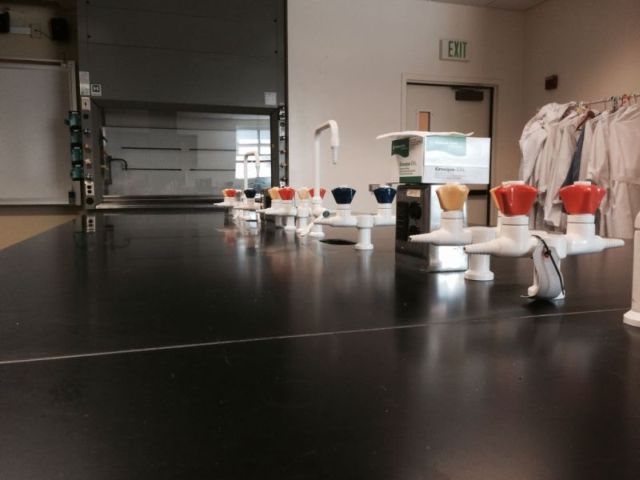
Faculty Research Profiles
Ahmed Awad, Ph.D. – Organic Synthesis, Nucleic Acid Chemistry
Dr. Awad's research area is in the interface between chemistry and biology. He is interested in investigation of novel drugs for the treatment of cancer. This includes chemical synthesis of modified nucleosides, nucleotides and nucleic acids (called therapeutic nucleic acids). The applications of these synthetic molecules in biological systems, as anticancer agents, constitute the major part of my research. I am interested in Pancreatic and Prostate cancer. Another branch of my research is focused on real-time measuring of the gene expression in case of cancer and therefore bringing novel methods to detect cancer in an early state, and so cancer can be treated before it develops.
Blake Gillespie, Ph.D. – Biochemistry, Protein Structure and Dynamics
Dr. Gillespie's research goals stem from an abiding interest in the structure of living organisms at their smallest scale, and of proteins in particular. Molecular architecture and structure determine the chemical behavior of proteins. This chemistry in turn governs the activity of molecules. All organisms require active molecules to carry out every aspect of living, and damaged or non-functional proteins are often at the root of disease. Therefore, biomolecular structure is in a very real sense the fundamental language for understanding all life.
In particular, Dr. Gillespie uses a variety of biophysical tools to characterize protein structure and dynamics. These range from spectroscopic methods such as circular dichroism and fluorescence to analytical techniques like differential scanning calorimetry and ultracentrifugation to tools for high-resolution structural studies such as NMR and X-ray crystallography. Using small proteins and simplified model systems, he addresses basic problems in biophysics, such as the physical basis of protein thermostability, the role of natural selection in determining protein folding kinetics, and the hydrodynamic properties of protein unfolded states.
Brittnee Veldman, Ph.D. – Physical Chemistry, Materials Chemistry
Dr. Veldman's research is in the field of materials chemistry which looks at projects that blend chemistry, physics and engineering. The goal of her research is to build lighter and more energy efficient electronics by optimizing the materials from which they are made. By understanding how the structure and interactions of molecules change the physical properties of a material, it is possible to design better materials for a given application.
Currently, students in her group are working to synthesize high-dielectric, nano-composite materials for use in flexible transistors. They also design, build, and program lab equipment from Arduino and Lego; and develop new tools and techniques to measure and model the capacitance of the nano-composite films.
William Munroe, Ph.D. – Biochemistry
Currently, Dr. Munroe's group is focusing on examining the ability of common baker’s yeast, Saccharomyces cerevisiae, to grow under elevated gravitational fields. Recently, other authors have demonstrated that microorganisms can not only survive but actually grow at up to 400,000 x g!
The previous methods used to measure the growth rate of these microorganisms under these conditions is cumbersome at best. Therefore, their current aim is to develop a simpler assay to measure the growth of these microorganisms in real-time using the analytical ultracentrifuge.
Upon development of this assay, we can then begin to address the following questions:
-Are there specific mechanisms that allow growth to occur under these conditions?
-What types of changes occurs to the S. cerevisiae upon growth at these high g-forces?
-Are there strain variations for how well S. cerevisiae grows under these conditions?
-Do different microorganisms exhibit similar types of g-force survivability?
Thomas J. Schulze, Ph.D. – Organic Synthesis
Scope of Dr. Schulze's research is to establish a set of efficient, high-yield synthesis of ‘drug-gable’ macrocycles, following contemporary criteria (Lipinski’s Rule-Of-5, Topological Surface Area (TPSA), rotatable bonds). The macrocyclic molecule class is characterized by retaining the best of both low molecular weight (MW) organic molecules, and high-specificity, high MW protein biologics: macrocycles display a high degree of domain efficiency towards their respective biological targets. Hence, his research objectives are to a) establish a systematic, stereo-controlled organic synthesis of medium-ring size (9, 10, and 11-membered) macrocycles with peptidomimetic properties (amino acid side chains, but: peptide-bond isosteres), and b) systematically correlate ring-size, functional group pattern, and side chain stereochemistry with inhibition, or modulation, of Protein-Protein Interaction (PPI) model systems. To-date, PPIs are consistently reported to be governed by ‘hot-spot’ domain interactions, in which specific protein domains interact with counterpart protein clefts, mainly due to non-polar interaction of a narrow set of ‘hot-spot’, non-polar amino acid residues. A stereo-selective 5-step synthesis of a 9-membered azeninone macrocycle, as initial model system, is ongoing.
